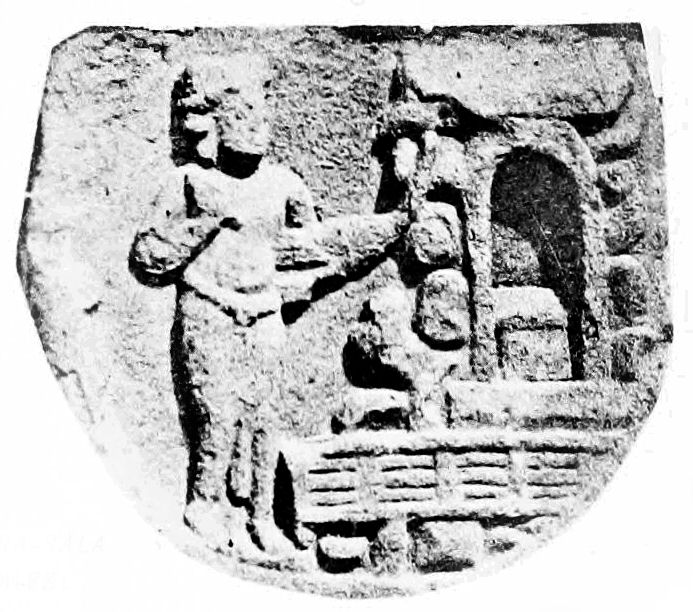Indrasaila cave on:
[Wikipedia]
[Google]
[Amazon]

 The Indrasala Cave, also called Indrasila Guha or Indrasaila Cave, is a cave site mentioned in
The Indrasala Cave, also called Indrasila Guha or Indrasaila Cave, is a cave site mentioned in
Upalavanna
File:Bodh Gaya Jataka medallion.jpg, Visit of Indra to the Indrasala cave. The Buddha is symbolized by his throne in the cave (

 The Indrasala Cave, also called Indrasila Guha or Indrasaila Cave, is a cave site mentioned in
The Indrasala Cave, also called Indrasila Guha or Indrasaila Cave, is a cave site mentioned in Buddhist
Buddhism ( , ), also known as Buddha Dharma and Dharmavinaya (), is an Indian religion or philosophical tradition based on teachings attributed to the Buddha. It originated in northern India as a -movement in the 5th century BCE, and ...
texts. It is stated in Buddhist mythology to be the cave where Buddha
Siddhartha Gautama, most commonly referred to as the Buddha, was a wandering ascetic and religious teacher who lived in South Asia during the 6th or 5th century BCE and founded Buddhism.
According to Buddhist tradition, he was born in L ...
lived for a while, and gave the sermon called the ''Sakkapañha Sutta'' to deity Indra. This ''Sutta'' is found as chapter II.21 of ''Dīgha Nikāya
The Digha Nikaya (dīghanikāya; "Collection of Long Discourses") is a Buddhist scriptures collection, the first of the five Nikāyas, or collections, in the Sutta Pitaka, which is one of the "three baskets" that compose the Pali Tipitaka of ...
''.; For one Theravada tradition translation of D II.21Upalavanna
Legend
In the ''Sakkapañha Sutta'' sermon, the Buddha addresses Sakra (also known as Indra) accompanied byPancasikha
Pancasikha (Sanskrit: ''Pañcaśikha''; Pali: ''Pañcasikha'') is a gandharva in the Buddhist pantheon.
Character
Pañcaśikha is the god who receives messages from the Four Heavenly Kings and their ministers regarding the deeds done in the hum ...
(also known as Kubera). After some harp-playing by Pancasikha, Indra asks 42 questions to the Buddha, which he answers. The teachings in this Indrasala Cave ''Sutta'' is, in part, the basis for the Theravada
''TheravƒÅda'' () ( si, ý∂Æý∑öý∂ªý∑Äý∑èý∂Øý∂∫, my, ·Äë·Ä±·Äõ·Äù·Ä´·Äí, th, ýπÄý∏ñý∏£ý∏ßý∏≤ý∏ó, km, ·ûê·üÅ·ûö·ûú·û∂·ûë, lo, ýªÄý∫ñý∫£ý∫∞ý∫ßý∫≤ý∫î, pi, , ) is the most commonly accepted name of Buddhism's oldest existing school. The school' ...
tradition of ''punna'' (earning merit) and'' varam'' (favor)''.''
Location
Buddhist texts mention the Indrasala Cave to be in the Vediya or Vediyaka mountain, to the north of Ambasanda, nearRajagrha
Rajgir, meaning "The City of Kings," is a historic town in the district of Nalanda in Bihar, India. As the ancient seat and capital of the Haryanka dynasty, the Pradyota dynasty, the Brihadratha dynasty and the Mauryan Empire, as well as the ...
.
Since the 19th century, many scholars had attempted to identify this hill and the location of the Indrasala Cave where Buddha lived. Alexander Cunningham believed it to be in modern Giryak.
More recently, a cave on the solitary hill in Parbati village (also known as Parwati or Parwatipur) in Nawada
Nawada is a city and a municipality in Bihar, India. It is also the headquarters of the Nawada district.
It is the headquarters of the subdivision of the same name, lying on both sides of the Khuri River( also known as Sakri river in some part ...
has been favoured, which is situated north to the village of Apsarh (modern-day Ambasanda).
Depictions
Numerous depictions of the scene are known, the earliest being those of theMahabodhi Temple
The Mahabodhi Temple (literally: "Great Awakening Temple") or the Mahābodhi Mahāvihāra, a UNESCO World Heritage Site, is an ancient, but rebuilt and restored Buddhist temple in Bodh Gaya, Bihar, India, marking the location where the Buddha i ...
at Bodh Gaya, circa 150 BCE. In a Gandhara artwork dated to 89 CE, the scene "Visit to the Indrasala Cave" is depicted with Indra identifiable with his elephant seated to the right, the Buddha is shown living in a cave by the wavy rocky landscape with wild animals above.
Mahabodhi Temple
The Mahabodhi Temple (literally: "Great Awakening Temple") or the Mahābodhi Mahāvihāra, a UNESCO World Heritage Site, is an ancient, but rebuilt and restored Buddhist temple in Bodh Gaya, Bihar, India, marking the location where the Buddha i ...
, Bodh Gaya, circa 150 BCE).
File:Indrasala Buddha with Indra, Mathura 50-100 CE.jpg, The same scene in a 50-100 CE relief, Mathura art
The Art of Mathura refers to a particular school of Indian art, almost entirely surviving in the form of sculpture, starting in the 2nd century BCE, which centered on the city of Mathura, in central northern India, during a period in which Bud ...
File:Indrasala cave, Loriyan Tangai.jpg, The same scene in a c. 2nd-century relief from Loriyan Tangai, Gandhara. The Buddha is shown in Indrasala cave.
File:Cambogia, frontone con la visita di indra a buddha nella grotta d'indrasaila, da preah khan, stile di bayon, 1190-1210 ca..JPG, Indra visiting the Buddha in the Indrasala cave, Preah Khan, style of the Bayon
The Bayon ( km, ·ûî·üí·ûö·û∂·ûü·û∂·ûë·ûî·û∂·ûô·üê·ûì, ) is a richly decorated Khmer temple related to Buddhism at Angkor in Cambodia. Built in the late 12th or early 13th century as the state temple of the King Jayavarman VII ( km, ·ûñ·üí·ûö·ü ...
, Cambodia
Cambodia (; also Kampuchea ; km, ·ûÄ·ûò·üí·ûñ·ûª·ûá·û∂, UNGEGN: ), officially the Kingdom of Cambodia, is a country located in the southern portion of the Indochinese Peninsula in Southeast Asia, spanning an area of , bordered by Thailan ...
, 1190-1210 CE.
See also
*Vulture Peak
The Vulture Peak (Pali: ý§óý§øý§úý•çý§ùý§ïý•Çý§ü, Sanskrit: ý§óý•Éý§¶ý•çý§ßý§ïý•Çý§ü), also known as the Holy Eagle Peak or Gridhak≈´ta (or GƒÅdhrak≈´ta), was the Buddha's favorite retreat in Rajagaha (now Rajgir, or Rajagrih). It was the scene ...
References
{{Indian Buddhist Caves * Indian rock-cut architecture Gautama Buddha